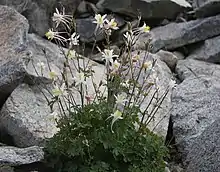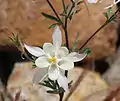Aquilegia pubescens
Aquilegia pubescens is a high-altitude species of columbine known by the common names Sierra columbine, alpine columbine and Coville's columbine. Its flowers are large and usually a creamy white.
| Aquilegia pubescens | |
|---|---|
 | |
| Scientific classification | |
| Kingdom: | Plantae |
| Clade: | Tracheophytes |
| Clade: | Angiosperms |
| Clade: | Eudicots |
| Order: | Ranunculales |
| Family: | Ranunculaceae |
| Genus: | Aquilegia |
| Species: | A. pubescens |
| Binomial name | |
| Aquilegia pubescens | |
Distribution
This wildflower is endemic to California, where it is a resident of the High Sierra. It is found in alpine and subalpine climates, often on open, rocky slopes, between 8,000 and 12,000 ft.[1]
Description
This leafy columbine rarely reaches half a meter-1.5 feet in height. The showy flowers are erect or spreading, rather than drooping. The characteristic spurs may be up to 5 centimeters long and the flowers up to 5 cm wide. The sepals (outer ring) and the petals (inner, with spurs) are generally cream or white, less often pink or yellow. The round, fused mouth protrudes, enclosing a cluster of long yellow stamens.[1]
Hybrids
Aquilegia pubescens (Sierra columbine) can hybridize with the lower-elevation Aquilegia formosa (crimson columbine) where their ranges overlap. This produces flowers with intermediate color, spur length, and orientation, as shown in the transition-series image, providing a change also in pollinator species: hawkmoths for A pubescens and hummingbirds for A. formosa.[2]
Gallery
 Aquilegia pubescens flower, full-face
Aquilegia pubescens flower, full-face Aquilegia pubescens bud & flowers
Aquilegia pubescens bud & flowers An unusual Aquilegia pubescens at Red Butte Gardens
An unusual Aquilegia pubescens at Red Butte Gardens
